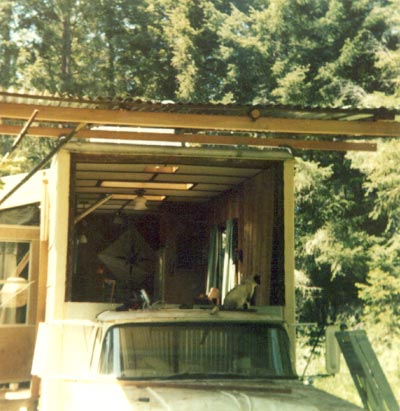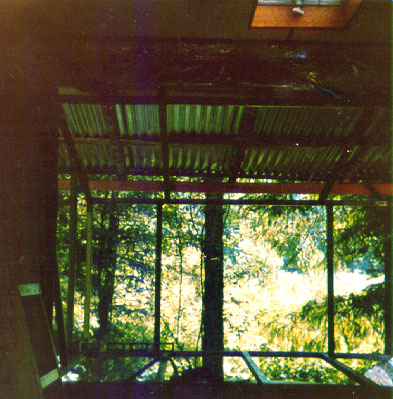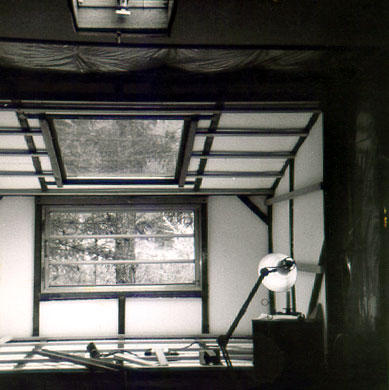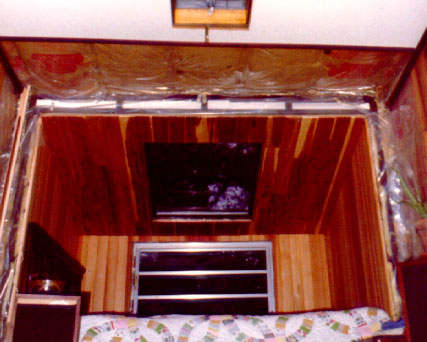Housetruck Loft Construction
Although I intended to post this in the "30 Years" topic thread when the time was right, here it is now, I can always copy-and-paste it over to that topic later.
Construction of the cab-over loft on my Housetruck took place over the summer of 1979. Up until then, the front of the truck was a flat box, with a window in the front:

There was a wooden loft built inside the box, with a desk and dresser underneath. The height of the loft was always a problem, not high enough to walk under, and a short ceiling in the sleeping portion. I was always digging my nails into the ceiling tiles when I'd roll over at night. The aluminum ladder was a cold experience in the morning for bare feet:

I started by building a pole and corrugated steel roofing shelter over the front of the truck. I removed the interior loft and using a borrowed generator (I was living far back in the woods then), a skilsaw with a cut off wheel was used to cut out the front of the box:

The cat is Moustache, and he was quite pleased with his new extra-sized cat door.
While the truck was under construction, I moved my bed room into a nearby vacant cabin on the property, only the second time in the last 32 years that I've even partially moved out of the truck.
A framework of 1-1/2" steel box tubing was gas welded to the remaining steel framing. There were two box tubing supports at the sides of the opening in the photo above. The metal to the outside of those sections of framing is very thick, high carbon steel channel formed into kind of a double "G" shape. It is rounded at the outside corners, and forms the radius of the corner of the box. I decided to rely on it's strength and integration into the box body as the major support for the new loft. Steel tubing was welded at the top and bottom of the opening in the box, and joists and rafters were added, with openings for the old front window and a new, commercially-manufactured skylight over the bed. This dark photo is looking out from inside the truck:

You can just see the diagonal brace running from about half-height in the loft to the floor of the loft. The structure seemed very solid without any other forms of support such as corner braces underneath. The combination of this steel box tubing brace and the continuous bracing provided by the exterior sheet metal made cantilevering the loft over the cab possible. Many of the corners of the framing were renforced with gussets welded in to relieve any stresses on the intersection of the various members.
A sheet metal fabrication shop custom made all of the sheathing for the outside of the loft. Galvanized steel was used for the roof, with mild steel sheeting on the walls and aluminum for the underside of the loft. All of it was held in place by pop rivets, set in place with a rented pneumatic riveter.
After the window and skylight were installed, I fitted styrene insulation between the framing members, and began installing wood furring strips to hold a second layer of fiberglass insulation and to support the interior paneling.

After the better part of Spring, Summer and Fall, the loft was enclosed and I moved out of the bedroom cabin and back into the truck. Primer was applied to the exterior to prevent rust:

Note the large dent in the hood and the crushed bike rack. A tree had fallen on the front of the truck about a year before this was taken. Before the current paint job was applied, I replaced the hood and built a new bike rack from an ornate bed frame.
It took a few more months of part-time work of finish off then interior. Here you can see the clear grain cedar paneling and aromatic cedar "closet lining" paneling that I used for the ceiling. The mahogany skylight trim, redwood window trim, custom lights, and the parts and pieces needed to integrate the new construction into the interior of the truck are still to come:

When I finally pulled the truck out of the woods and back to the road in preparation for my trip to Santa Cruz in 1981, I was aprehensive about how the loft would hold up to the trucks movement, and a bit concerned about what the additional weight was going to do the the ride and handling of the chassis. Neither proved to be an issue. The handling was always a bit like butter on a hot skillet, wallowing down the road.
Original material ©1996-2025 Mr. Sharkey | All rights reserved
